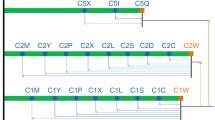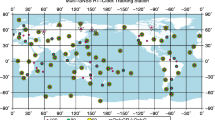Abstract
With the modernization of GPS and the establishment of additional global navigation satellite system (GNSS) constellations, such as Galileo, Beidou, and QZSS, more and more GNSS satellites are available transmitting on various frequencies with multiple signal modulations. In order to cope with the increasing number of observation types, the commonly used differential approach becomes more and more difficult regarding book-keeping. The actually processed original observation types have to be known in advance to define a linearly independent set of differential signal biases (DSB) while processing GNSS data. An alternative treatment of code biases is the usage of observable-specific signal biases (OSB) where the setup and correction of biases become trivial. Potential dependencies of the bias parameters can be considered after the setup of normal equations (NEQs), e.g., immediately before it is inverted. The code bias results are retrieved on a daily basis and their NEQs stored. This allows to combine bias results from various sources (or analysis lines) and different time periods. By combining all daily bias NEQs, we have generated a coherent multi-year bias solution from 2000 to 2017 with one common datum. If absolute receiver calibrations are available, the multi-year solution could be aligned to those receivers and thus could lead to an absolute estimation of the code biases. Finally, the estimated satellite OSBs are used for the receiver compatibility grouping testing which receivers are compatible with which bias sets. This may be achieved by solving for so-called OSB multipliers.








Similar content being viewed by others
Data availibility
All the used data, including orbits and observation data, are publicly available from CODE (orbits) and the IGS (observation data). The OSB results from our multi-GNSS processing are publicly available as BIAS-SINEX files. The long-term bias analysis data are not yet publicly available due to ongoing research.
References
Dach R, Lutz S, Walser P, Fridez P (2015) Bernese GNSS Software Version 5.2. University of Bern, Bern Open Publishing
Dow JM, Neilan RE, Rizos C (2009) The International GNSS Service in a Changing Landscape of Global Navigation Satellite Systems. J Geod 83(3–4):191–198
Guo F, Zhang X, Wang J (2015) Timing group delay and differential code bias corrections for beidou positioning. J Geod 89(5):427–445
Gurtner W, Lou E (2012) RINEX The Receiver Independent Exchange Format Version 2.11. International GNSS Service (IGS), RINEX Working Group and Real-Time Working Group
Håkansson M, Jensen ABO, Horemuz M, Hedling G (2017) Review of code and phase biases in multi-GNSS positioning. GPS Solut 21(3):849–860
Hauschild A (2017) Combination of observations. In: Teunissen PJ, Montenbruck O (eds) Springer Handbook of Global Navigation Satellite Systems. Springer, Berlin
IS-GPS-200J (2018). Interface specification is-gps-200: Navstar gps space segment/navigation user segment interfaces
Meurer M, Antreich F (2017) Signals and modulation. In: Teunissen PJ, Montenbruck O (eds) Springer Handbook of Global Navigation Satellite Systems. Springer, Berlin
MGEX (2017) IGS homepage of the IGS Multi-GNSS Experiment. http://igs.org/mgex. (Dec 2017)
Montenbruck O, Hauschild A, Steigenberger P (2014) Differential Code Bias Estimation Using Multi-GNSS Observations and Global Ionosphere Maps. Navigation 61(3):191–201 NAVI-2013-068
Montenbruck O, Hugentobler U, Dach R, Steigenberger P, Hauschild A (2012) Apparent clock variations of the Block IIF-1 (SVN62) GPS satellite. GPS Solut 16(3):303–313
Montenbruck O, Steigenberger P, Prange L, Deng Z, Zhao Q, Perosanz F, Romero I, Noll C, Stürze A, Weber G, Schmid R, MacLeod K, Schaer S (2017) The Multi-GNSS Experiment (MGEX) of the International GNSS Service (IGS)—achievements, prospects and challenges. Adv Space Res 59(7):1671–1697 Article
Prange L, Orliac E, Dach R, Arnold D, Beutler G, Schaer S, Jäggi A (2017a) CODE’s five-system orbit and clock solution—the challenges of multi-GNSS data analysis. J Geod 91:345–360
Prange L, Susnik A, Arnold D, Dach R, Schaer S, Sidorov D, Villiger A, Jäggi A (2017b) CODE product series for the IGS MGEX project. Published by Astronomical Institute, University of Bern
RINEX 3.03 (2015) RINEX The Receiver Independent Exchange Format Version 3.03. International GNSS Service (IGS), RINEX Working Group and Radio Technical Commission for Maritime Services Special Committee 104 (RTCM-SC104)
RTCM (2016) RTCM 10403.3, Differential GNSS (Global Navigation Satellite Systems) Services—Version 3 (October 7, 2016), RTCM Standard 10403.3
Schaer S (2017) SINEX\_BIAS-Solution (Software/technique) INdependent EXchange Format for GNSS Biases Version 1.00
Wang N, Yuan Y, Li Z, Montenbruck O, Tan B (2016) Determination of differential code biases with multi-GNSS observations. J Geod 90:209–228
Wanninger L, Sumaya H, Beer S (2017) Group delay variations of gps transmitting and receiving antennas. J Geod 91(9):1099–1116
Wilson BC, Yinger CH, Feess WA, Shank CC (1999) The broadcast interfrequency biases. GPS World 10(9):56–66
Acknowledgements
Calculations were performed on UBELIX (http://www.id.unibe.ch/hpc), the HPC cluster at the University of Bern.
Author information
Authors and Affiliations
Contributions
A.V., S.S., and R.D. designed the research; A.V. performed the research and wrote the paper; A.V. and S.S. analyzed the data; R.D., L.P., and A.S. contributed to the data analyzes; S.S, R.D, L.P., A.S., and A.J. gave helpful suggestions during the internal reviewing process.
Corresponding author
Rights and permissions
About this article
Cite this article
Villiger, A., Schaer, S., Dach, R. et al. Determination of GNSS pseudo-absolute code biases and their long-term combination. J Geod 93, 1487–1500 (2019). https://doi.org/10.1007/s00190-019-01262-w
Received:
Accepted:
Published:
Issue Date:
DOI: https://doi.org/10.1007/s00190-019-01262-w




